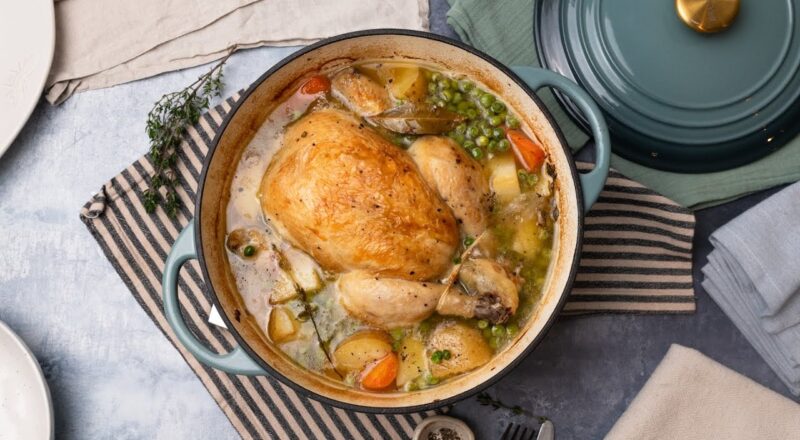In the world of culinary artistry, the cast iron braiser stands out as a versatile and essential tool. Its ability to retain heat and distribute it evenly makes it a favorite among home cooks and professional chefs alike. However, to make the most out of your cast iron braiser, especially when it comes to reheating meals, there are some essential tips and techniques you need to know. In this article, we’ll delve into everything you need to know about cast iron braiser reheating tips, ensuring your meals are as delicious as they were when first cooked.

Why Choose a Cast Iron Braiser?
The cast iron braiser is renowned for its versatility. It’s perfect for browning, simmering, and even baking. But why is it ideal for reheating? The ability of cast iron to maintain a consistent temperature makes it excellent for restoring leftovers to their original glory. Whether you’re reheating a stew or a casserole, the braiser’s thick walls and heavy lid ensure that food is heated evenly, preventing dry or unevenly warmed meals.
Benefits of Using Cast Iron for Reheating
One of the key advantages of using a cast iron braiser for reheating is its superior heat retention. Unlike other cookware, cast iron retains heat long after being removed from the stove, ensuring that food stays warm. Additionally, the non-stick surface that develops over time allows for easy cleaning and prevents food from sticking during the reheating process.
Step-by-Step Guide to Reheating in a Cast Iron Braiser
Step 1: Preheat the Braiser
Before adding your food, it’s crucial to preheat your cast iron braiser. This ensures that the heat is evenly distributed from the moment your food is introduced. Place the braiser on a medium flame for about 5 minutes, allowing it to warm up gradually.
Step 2: Add a Splash of Liquid
To prevent your food from drying out, add a small amount of liquid. This could be water, broth, or even a bit of wine. The liquid will create steam, helping to reheat the food gently while maintaining moisture.
Step 3: Stir Occasionally
Stirring your food occasionally helps to distribute the heat evenly and ensures that no part of your dish is left cold. Use a wooden spoon or a silicone spatula to avoid damaging the seasoning of your braiser.
Step 4: Monitor the Temperature
It’s essential to keep an eye on the temperature. A low to medium flame is ideal for reheating, as it prevents the food from burning or sticking to the bottom of the braiser. Adjust the heat as needed to maintain a gentle simmer.
Step 5: Serve and Enjoy
Once your food is heated through, it’s ready to serve. The even heating of the cast iron braiser will ensure every bite is as delightful as the first time you cooked it.
Common Mistakes to Avoid
Overheating the Braiser
One of the most common mistakes is overheating the cast iron braiser. This can lead to burnt food and damage to the seasoning. Always start with a medium flame and adjust as necessary.
Not Using Enough Liquid
Without sufficient liquid, your food can dry out quickly. Always add a splash of liquid to create steam and keep your dish moist.
Cleaning and Maintaining Your Cast Iron Braiser
Proper maintenance of your cast iron braiser is crucial for its longevity. After each use, clean it with hot water and a stiff brush. Avoid using soap, as it can strip the seasoning. For stubborn food residue, use a paste of coarse salt and water to scrub the surface. Dry your braiser thoroughly and apply a thin layer of oil to prevent rust.
Storage Tips
Store your cast iron braiser in a dry place. If stacking with other cookware, place a paper towel between each item to prevent scratching. For more tips on preventing rust, check out prevent rust on cast iron.

FAQs About Cast Iron Braiser Reheating
Can I reheat food in the oven with my cast iron braiser?
Yes, the cast iron braiser is oven-safe and perfect for reheating dishes like casseroles or stews. Ensure the lid is also oven-safe before using it in the oven.
Is it necessary to re-season my braiser after each use?
Not necessarily. As long as you clean and dry your cast iron braiser properly after each use, frequent re-seasoning isn’t required. A light layer of oil after cleaning will help maintain the seasoning.
What should I do if my food sticks to the braiser?
If food sticks, soak the braiser in hot water and gently scrub with a brush. Avoid using metal utensils or harsh scrubbers that can damage the seasoning.
For more insights on using a braiser, you might want to explore the differences between a braiser and a casserole pot or learn about indoor grilling with cast iron.
If you’re interested in the benefits of braiser cooking, you could also visit dutch ovens vs. braisers for more information.
This article contains affiliate links. We may earn a commission at no extra cost to you.

